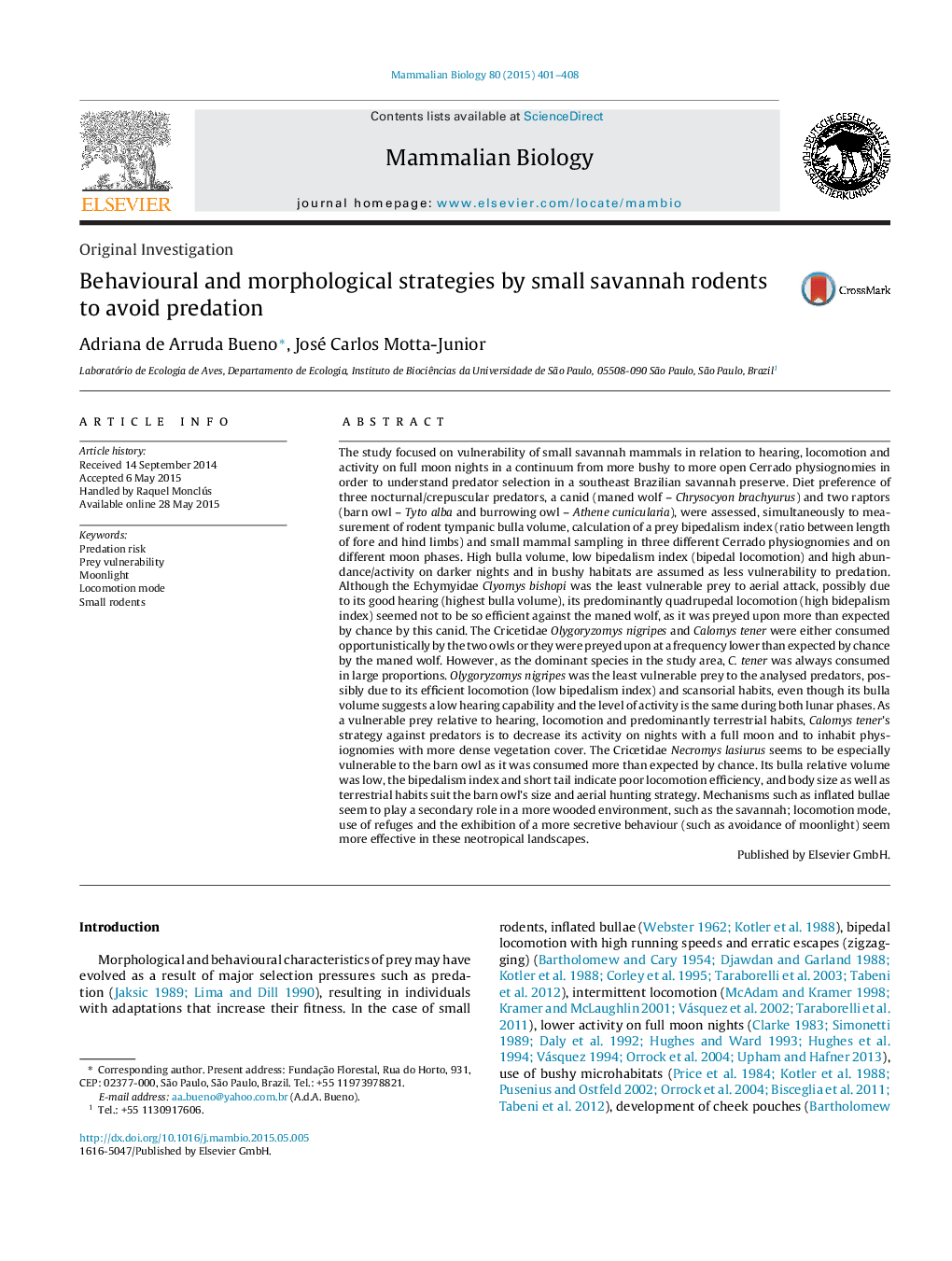| کد مقاله | کد نشریه | سال انتشار | مقاله انگلیسی | نسخه تمام متن |
|---|---|---|---|---|
| 10955839 | 1098374 | 2015 | 8 صفحه PDF | دانلود رایگان |
عنوان انگلیسی مقاله ISI
Behavioural and morphological strategies by small savannah rodents to avoid predation
ترجمه فارسی عنوان
استراتژی های رفتاری و مورفولوژیکی توسط جوندگان کوچک توسان برای جلوگیری از شکارچیان
دانلود مقاله + سفارش ترجمه
دانلود مقاله ISI انگلیسی
رایگان برای ایرانیان
کلمات کلیدی
ریسک جبرانی، آسیب پذیری شکار، مهتاب، حالت لوکوموتیو، جوندگان کوچک،
موضوعات مرتبط
علوم زیستی و بیوفناوری
علوم کشاورزی و بیولوژیک
علوم دامی و جانورشناسی
چکیده انگلیسی
The study focused on vulnerability of small savannah mammals in relation to hearing, locomotion and activity on full moon nights in a continuum from more bushy to more open Cerrado physiognomies in order to understand predator selection in a southeast Brazilian savannah preserve. Diet preference of three nocturnal/crepuscular predators, a canid (maned wolf - Chrysocyon brachyurus) and two raptors (barn owl - Tyto alba and burrowing owl - Athene cunicularia), were assessed, simultaneously to measurement of rodent tympanic bulla volume, calculation of a prey bipedalism index (ratio between length of fore and hind limbs) and small mammal sampling in three different Cerrado physiognomies and on different moon phases. High bulla volume, low bipedalism index (bipedal locomotion) and high abundance/activity on darker nights and in bushy habitats are assumed as less vulnerability to predation. Although the Echymyidae Clyomys bishopi was the least vulnerable prey to aerial attack, possibly due to its good hearing (highest bulla volume), its predominantly quadrupedal locomotion (high bidepalism index) seemed not to be so efficient against the maned wolf, as it was preyed upon more than expected by chance by this canid. The Cricetidae Olygoryzomys nigripes and Calomys tener were either consumed opportunistically by the two owls or they were preyed upon at a frequency lower than expected by chance by the maned wolf. However, as the dominant species in the study area, C. tener was always consumed in large proportions. Olygoryzomys nigripes was the least vulnerable prey to the analysed predators, possibly due to its efficient locomotion (low bipedalism index) and scansorial habits, even though its bulla volume suggests a low hearing capability and the level of activity is the same during both lunar phases. As a vulnerable prey relative to hearing, locomotion and predominantly terrestrial habits, Calomys tener's strategy against predators is to decrease its activity on nights with a full moon and to inhabit physiognomies with more dense vegetation cover. The Cricetidae Necromys lasiurus seems to be especially vulnerable to the barn owl as it was consumed more than expected by chance. Its bulla relative volume was low, the bipedalism index and short tail indicate poor locomotion efficiency, and body size as well as terrestrial habits suit the barn owl's size and aerial hunting strategy. Mechanisms such as inflated bullae seem to play a secondary role in a more wooded environment, such as the savannah; locomotion mode, use of refuges and the exhibition of a more secretive behaviour (such as avoidance of moonlight) seem more effective in these neotropical landscapes.
ناشر
Database: Elsevier - ScienceDirect (ساینس دایرکت)
Journal: Mammalian Biology - Zeitschrift für Säugetierkunde - Volume 80, Issue 5, September 2015, Pages 401-408
Journal: Mammalian Biology - Zeitschrift für Säugetierkunde - Volume 80, Issue 5, September 2015, Pages 401-408
نویسندگان
Adriana de Arruda Bueno, José Carlos Motta-Junior,
